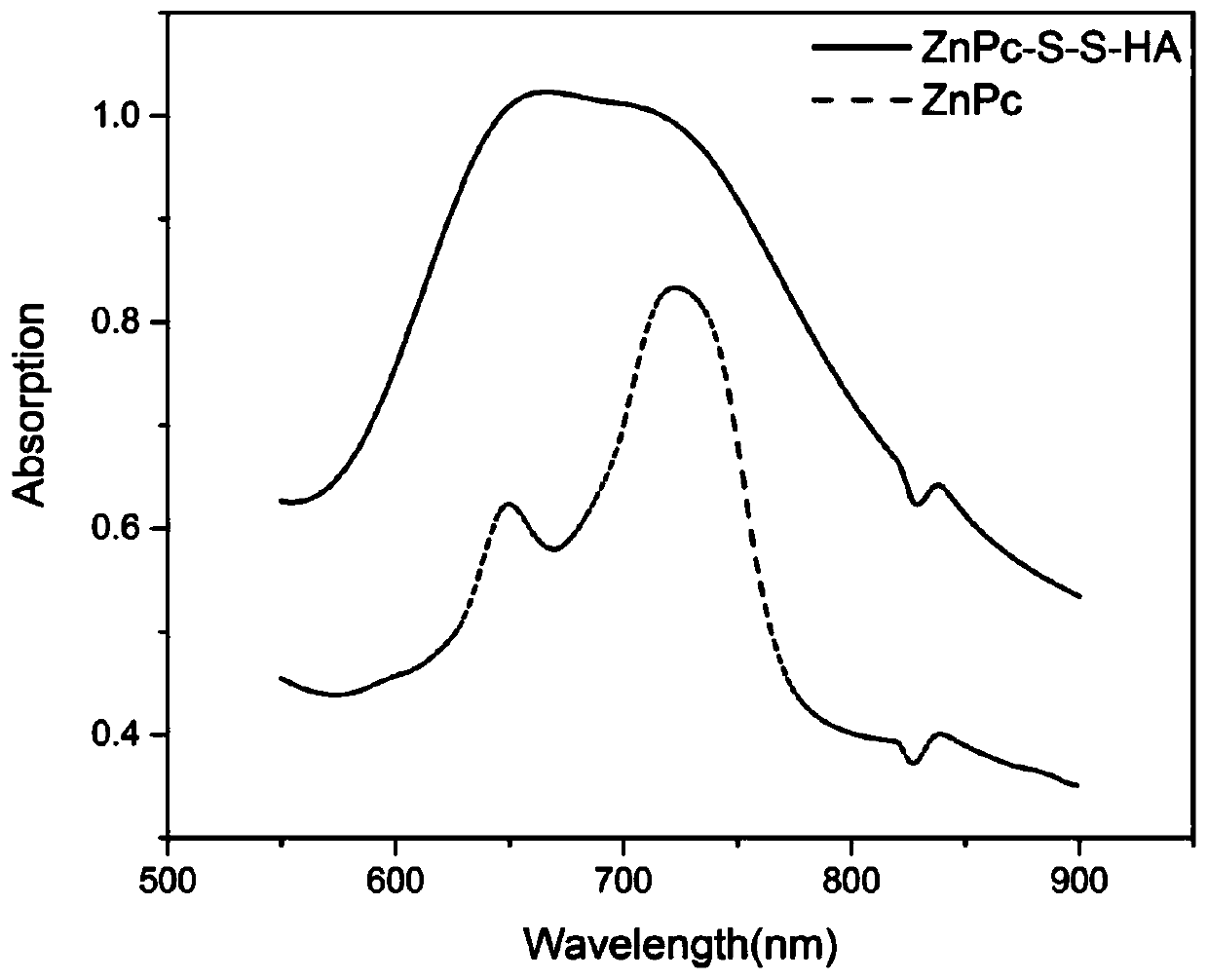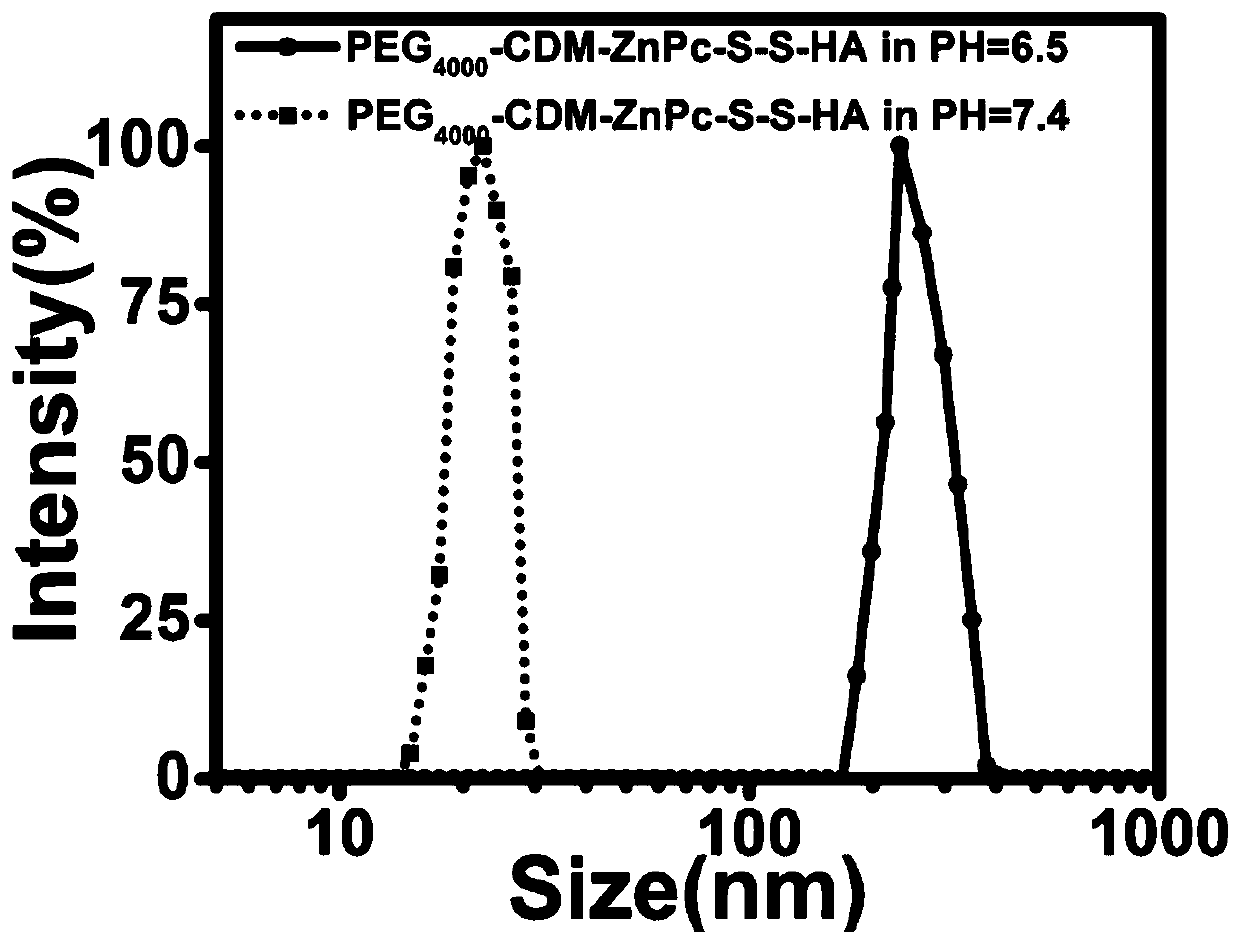Biological cascade reaction type photodynamic integrated biopolymer, preparation method and applications thereof
A technology of biopolymers and cascade reactions, applied in drug combinations, medical preparations containing active ingredients, pharmaceutical formulations, etc., can solve problems such as transmission and driving obstacles, achieve enhanced retention, increase tumor retention rate, and enhance blood loop effect
- Summary
- Abstract
- Description
- Claims
- Application Information
AI Technical Summary
Problems solved by technology
Method used
Image
Examples
Embodiment 1
[0044] Preparation of a biological cascade reaction photodynamic integrated biopolymer (PEG 4000 -CDM-ZnPc-S-S-HA), proceed as follows:
[0045] 1. Preparation of tetraamino zinc phthalocyanine (ZnPc):
[0046] (1) Put 4.1g 4-nitrophthalimide, 10g urea and 0.05g ammonium molybdate in a three-necked flask, heat to melt, add 1.2g zinc chloride hexahydrate and heat to 160℃, continue React until no bubbles are generated in the flask. After cooling, wash with 1mol / L HCL and 1mol / L NaOH solution, then wash with ultrapure water to neutrality, and vacuum dry to obtain a blue-purple product;
[0047] (2) Add the blue-violet product and 2.88g sodium sulfide nonahydrate into a three-necked flask, heat and add 15ml DMF to fully dissolve it. After heating to 60°C, increase the stirring speed. After reacting for 1h, wash with water until neutral, vacuum After drying and removing the solvent, a dark green solid substance, namely the product to be prepared, tetraamino zinc phthalocyanine (ZnPc), is...
Embodiment 2
[0065] The biological cascade reaction type photodynamic integrated biopolymer (PEG) prepared in Example 1 4000 -CDM-ZnPc-S-S-HA) for in vitro simulation experiments under acidic conditions:
[0066] The biological cascade reaction type photodynamic integrated biopolymer (PEG) prepared in Example 1 4000 -CDM-ZnPc-S-S-HA) TEM image such as figure 1 As shown in a, it can be seen that the polymer (PEG 4000 -CDM-ZnPc-S-S-HA) is an irregular macromolecule and does not form nanoparticles. Next, the biological cascade reaction type photodynamic integrated biopolymer (PEG) prepared in Example 1 4000 -CDM-ZnPc-S-S-HA) is treated under acidic conditions of pH=6.5, the TEM and SEM images of the treated product are as follows figure 1 As shown in b and c, it can be seen that the polymer has formed nanoparticles after being treated in acidic conditions of pH=6.5, indicating that the biological cascade reaction type photodynamic integrated biopolymer (PEG 4000 -CDM-ZnPc-S-S-HA) can self-assemble...
PUM
 Login to View More
Login to View More Abstract
Description
Claims
Application Information
 Login to View More
Login to View More - R&D
- Intellectual Property
- Life Sciences
- Materials
- Tech Scout
- Unparalleled Data Quality
- Higher Quality Content
- 60% Fewer Hallucinations
Browse by: Latest US Patents, China's latest patents, Technical Efficacy Thesaurus, Application Domain, Technology Topic, Popular Technical Reports.
© 2025 PatSnap. All rights reserved.Legal|Privacy policy|Modern Slavery Act Transparency Statement|Sitemap|About US| Contact US: help@patsnap.com



